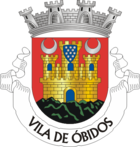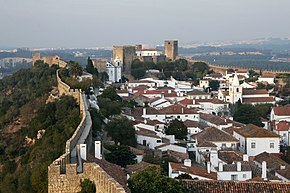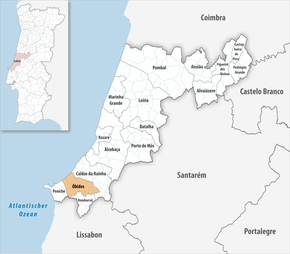Óbidos (Portugal)
| Óbidos | ||||||
|---|---|---|---|---|---|---|
|
||||||
| Basic data | ||||||
| Region : | Centro | |||||
| Sub-region : | Oeste | |||||
| District : | Leiria | |||||
| Concelho : | Óbidos | |||||
| Coordinates : | 39 ° 22 ′ N , 9 ° 10 ′ W | |||||
| Residents: | 11,772 (as of June 30, 2011) | |||||
| Surface: | 141.55 km² (as of January 1, 2010) | |||||
| Population density : | 83 inhabitants per km² | |||||
| Height: | 49 m | |||||
| Obidos district | ||||||
|
||||||
| Residents: | 11,772 (as of June 30, 2011) | |||||
| Surface: | 141.55 km² (as of January 1, 2010) | |||||
| Population density : | 83 inhabitants per km² | |||||
| Number of municipalities : | 7th | |||||
| administration | ||||||
| Administration address: | Câmara Municipal de Óbidos Edifício dos Paços do Concelho Largo de S. Pedro 2510-086 Óbidos |
|||||
| President of the Câmara Municipal: | Humberto da Silva Marques ( PSD ) | |||||
| Website: | www.cm-obidos.pt | |||||
Óbidos is a small town ( Vila ) and a district in the Portuguese region Centro and there in the sub-region Oeste in the historical area Estremadura . The place is known for its preserved historic center, completely surrounded by walkable city walls and lined with flower-filled streets.
history
Finds show a settlement since the Neolithic . The current place name perhaps goes back to the Latin word oppidum for a fortified town. Near the fortress town, the Roman city of Eburobrittium existed from the first century AD, according to other sources as early as the 4th or 3rd century BC. Founded. Óbidos became part of the Visigoth Empire in the 5th century , until the Moors conquered and re-fortified the city from 711 onwards .
In the course of the Reconquista , D.Afonso Henriques conquered the place for his young kingdom of Portugal in 1148 . Under King D.Sancho I , Óbidos received its first town charter in 1195 . King Alfonso II bequeathed the city to his wife Urraca as a wedding present. Since then and up to the 16th century, various kings repeated this custom, which is why the city was also called Vila das Rainhas (City of Queens).
In 1636 the titular county Óbidos was created and seven years later King D. João IV had the fortress walls renewed.
Óbidos suffered extensive damage to his buildings by the Lisbon earthquake in 1755 , which was followed by extensive rebuilding.
The Óbidos dam has existed since 2005.
Attractions
- The current city fortifications with city walls and castle were built between the 13th and 16th centuries. The castle was built by King Dinis in the 13th century, the city wall dates from 1527 and has remained unchanged until the 21st century. The wall is accessible all around; a pousada was set up at the castle . Every year in summer there is a medieval market in the whole town center .
- The church of Santa Maria originally dates from the 12th century. King Alfonso V and Isabel of Portugal married here in 1444 . The church is lined with azulejos and contains numerous paintings by the painter Josefa de Óbidos.
- Opposite the church there is a stake on a raised terrace , symbol of the municipality's municipal law.
- In front of the city wall, an aqueduct , which was built in 1570, leads water into the city from Usseira . It is still largely preserved.
- In the direction of Óbidos lagoon is bird watching possible paths are created.
Azulejo as house decoration in Óbidos (1994)
administration
Obidos district
Óbidos is the administrative seat of a district of the same name ( concelho ) in the Leiria district . On June 30, 2011 the district had 11,772 inhabitants on an area of 141.6 km².
The neighboring districts are (starting clockwise in the north): Caldas da Rainha , Bombarral , Lourinhã and Peniche . In the west, the district borders on the Atlantic Ocean .
With the territorial reform in September 2013, the municipalities ( freguesias ) Santa Maria , São Pedro and Sobral da Lagoa were merged to form the new municipality Santa Maria, São Pedro e Sobral da Lagoa . Since then, the district has consisted of the following seven municipalities:
The following municipalities ( Freguesias ) are in the Óbidos district:
| local community | Population (2011) |
Area km² |
Density of population / km² |
LAU code |
|---|---|---|---|---|
| A dos Negros | 1,489 | 17.49 | 85 | 101201 |
| Amoreira | 989 | 19.91 | 50 | 101202 |
| Gaeiras | 2,331 | 10.31 | 226 | 101208 |
| Olho Marinho | 1,279 | 18.12 | 71 | 101203 |
| Santa Maria, Sao Pedro e Sobral da Lagoa | 3,779 | 36.59 | 103 | 101210 |
| Usseira | 953 | 7.24 | 132 | 101209 |
| Vau | 952 | 31.89 | 30th | 101207 |
| Obidos district | 11,772 | 141.55 | 83 | 1012 |
Population development
| Population in Óbidos district | |||||||||
|---|---|---|---|---|---|---|---|---|---|
| 1801 | 1849 | 1900 | 1930 | 1960 | 1981 | 1991 | 2001 | 2004 | 2011 |
| 12,428 | 7,970 | 17,659 | 9,877 | 11,316 | 10,538 | 11,188 | 10,875 | 11,187 | 11,689 |
Municipal holiday
- 11th January
Town twinning
traffic
The historic town center is traffic-calmed, through the narrow streets the carriages run on tours for tourists and bicycles. Up until the Middle Ages, the Óbidos lagoon reached the town and allowed shipping, but the town's access to the waterway silted up afterwards.
Óbidos is on the Linha do Oeste railway line , the train station is around 500 m north of the town center.
The A8 motorway passes the town with its own exit, and the A15 ends here, where it meets the A8.
sons and daughters of the town
- Baltazar Gomes Figueira (1604–1674), painter
- Armando da Silva Carvalho (* 1938 in Olho Marinho; † 2017), writer and translator
- Carlos Zorrinho (* 1959), economist and socialist politician, MEP since 2014
- Josefa de Óbidos (1630–1684), painter
Web links
- Official website of the city administration (Portuguese, Spanish and English)
- Advertising page Óbidos ( Memento from April 16, 2012 in the Internet Archive ) on lisbonweekendguild.com (en)
- Photos from Óbidos , on Flickr
Individual evidence
- ↑ a b c www.ine.pt - indicator resident population by place of residence and sex; Decennial in the database of the Instituto Nacional de Estatística
- ↑ a b Overview of code assignments from Freguesias on epp.eurostat.ec.europa.eu
- ^ João Fonseca: Dicionário do Nome das Terras. 2nd edition, Casa das Letras, Cruz Quebrada 2007, p. 181 ( ISBN 978-9724617305 )
- ↑ www.verportugal.net , accessed October 29, 2013
- ^ Website of the Medieval Market (Portuguese, French and English), accessed on November 1, 2013
- ↑ www.avesdeportugal.info , accessed November 1, 2013
- ^ Publication of the administrative reorganization in the Diário da República gazette of January 28, 2013, accessed on March 16, 2014
- ↑ www.anmp.pt , accessed on November 1, 2013













